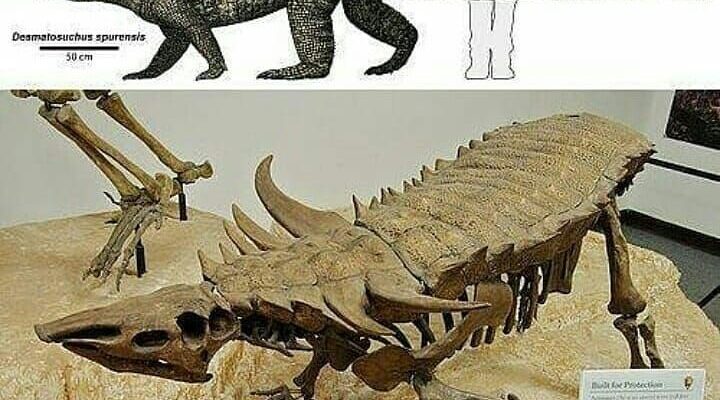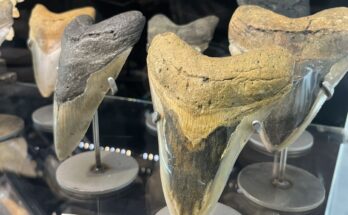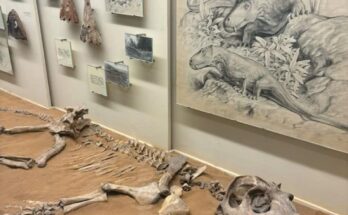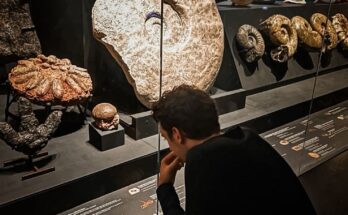Desmatosuchus spurensis: Unveiling the Armored Aetosaur of the Late Triassic Era

Introduction to Desmatosuchus spurensis
Desmatosuchus spurensis, a fascinating extinct archosaur from the Late Triassic period, represents one of the most heavily armored reptiles in prehistoric history. Belonging to the order Aetosauria, this creature roamed the landscapes of what is now North America approximately 228 to 210 million years ago, during the Carnian to Norian stages. Often described as a “walking tank” due to its robust defensive adaptations, Desmatosuchus spurensis was a herbivorous pseudosuchian—a group closely related to modern crocodiles but with distinct evolutionary traits that set it apart from today’s reptiles. This detailed exploration, inspired by a compelling image featuring a life reconstruction alongside a fossil skeleton, delves into the anatomy, lifestyle, and scientific significance of this ancient beast, providing a comprehensive guide akin to a paleontological tutorial for enthusiasts and researchers alike.
The image in question captures the essence of Desmatosuchus spurensis perfectly: the upper portion shows an artistic reconstruction of the living animal next to a human silhouette for scale, emphasizing its impressive length and formidable spikes, while the lower section displays a mounted fossil skeleton on exhibit, complete with a informational plaque titled “Built for Protection.” Such visuals not only highlight the creature’s physical prowess but also bridge the gap between fossil evidence and imaginative restoration, allowing us to visualize how this armored giant might have appeared in its natural environment.
Taxonomy and Evolutionary Context
To understand Desmatosuchus spurensis, we begin with its taxonomic classification, which places it firmly within the archosaur lineage. The full scientific hierarchy is as follows:
- Kingdom: Animalia
- Phylum: Chordata
- Class: Reptilia
- Clade: Archosauria
- Clade: Pseudosuchia
- Order: †Aetosauria
- Family: †Stagonolepididae
- Subfamily: †Desmatosuchinae
- Genus: †Desmatosuchus (Case, 1920)
- Species: †D. spurensis (Case, 1921)
The genus Desmatosuchus includes valid species such as D. spurensis and D. smalli, with historical synonyms like Episcoposaurus haplocerus now considered dubious. Aetosaurs like Desmatosuchus were part of a diverse group of Triassic herbivores, evolving alongside early dinosaurs but on a separate branch of the archosaur tree. Unlike the bipedal, carnivorous dinosaurs that dominated popular imagination, aetosaurs were quadrupedal, armored, and adapted for a life of foraging in lush, riverine habitats. This evolutionary niche allowed them to thrive in ecosystems teeming with predators, relying on passive defenses rather than speed or aggression.
Physical Description and Anatomy
Desmatosuchus spurensis was a large, quadrupedal reptile measuring between 4.5 to over 5 meters (15 to 16 feet) in length and weighing approximately 280–300 kilograms (620–660 pounds). Its body was broad and robust, with disproportionately shorter forelimbs compared to its hindlimbs—the humeri were less than two-thirds the length of the femurs—giving it a somewhat awkward but powerful stance. The skull was relatively small, averaging 37 centimeters long, 18 centimeters wide, and 15 centimeters high, featuring a shovel-like snout formed by upturned premaxillae that lacked teeth, suggesting a specialized feeding mechanism.
One of the most striking features was its extensive armor, composed of osteoderms (bony plates) arranged in rows along its back. The carapace included two median rows of scutes flanked by lateral rows, with the latter bearing prominent spine-like processes that pointed laterally and posteriorly. These spines, unique among aetosaurs, could reach up to 28 centimeters in length, particularly the recurved anterior ones over the shoulders, which resembled scythes or horns. Variations in spine size may indicate sexual dimorphism or display purposes. The dentition was homodont, with blunt, bulbous teeth suited for processing vegetation, and the jaws articulated in a manner that kept tooth rows parallel, reminiscent of ornithischian dinosaurs.
The skeletal structure further reveals adaptations for stability and protection: three sacral vertebrae supported a strong pelvic girdle with a long pubis, plate-like ischium, and deep acetabulum. The crurotarsal ankles and large calcaneal tubers provided hefty heels, enhancing its ability to navigate uneven terrain.

Habitat, Diet, and Paleobiology
Fossils of Desmatosuchus spurensis are abundant in formations like the Dockum and Chinle in the southwestern United States, indicating a habitat rich in lakes, rivers, and floodplains during the Late Triassic. This environment, characterized by seasonal wetness and abundant low-growing vegetation, was ideal for a creature adapted to foraging near waterways. As a primarily herbivorous animal, Desmatosuchus used its shovel-shaped snout and horny sheaths on toothless jaw tips to uproot soft plants, possibly digging in mud for roots or tubers. While some speculate omnivory or insectivory due to armadillo-like traits, the consensus leans toward herbivory, supported by its dental morphology and lack of forelimb digging adaptations.
Behaviorally, evidence suggests Desmatosuchus may have lived in herds or family groups, as multiple skeletons have been found clustered together. This social structure could have offered additional protection against predators like Postosuchus, whose remains are sometimes intermixed with aetosaur bones, hinting at predation events. Despite its armor, Desmatosuchus was not invincible; its mobility—enhanced by a deep acetabulum, femoral crest, and elongate pubis—allowed it to outpace many contemporaries, making it a dominant herbivore in its ecosystem.
Discovery History and Notable Fossils
The discovery of Desmatosuchus dates back to the late 19th century when E.D. Cope described armor fragments from the Dockum Group as Episcoposaurus haplocerus. In the 1920s, E.C. Case named Desmatosuchus spurensis based on a partial skeleton from the Tecovas Formation. Subsequent revisions in 2008 by William Parker clarified the taxonomy, designating D. spurensis as the type species. Notable specimens include those from the Petrified Forest National Park in Arizona, where mounted skeletons like the one in the provided image are displayed with plaques explaining their protective adaptations.

These fossils, often found in quarries like the Post Quarry, provide invaluable insights into Triassic biodiversity.
Conclusion: Legacy in Paleontology
Desmatosuchus spurensis stands as a testament to the ingenuity of evolution, showcasing how armor and specialization allowed non-dinosaur archosaurs to flourish in a predator-filled world. By studying images and fossils like those depicted, we gain a deeper appreciation for the Triassic period’s ecological dynamics. For those interested in further exploration, visiting sites like the Smithsonian or Petrified Forest offers hands-on encounters with these ancient wonders. This guide serves as a starting point for delving into paleontology, encouraging readers to explore related genera and contribute to ongoing research through citizen science or academic pursuits.
